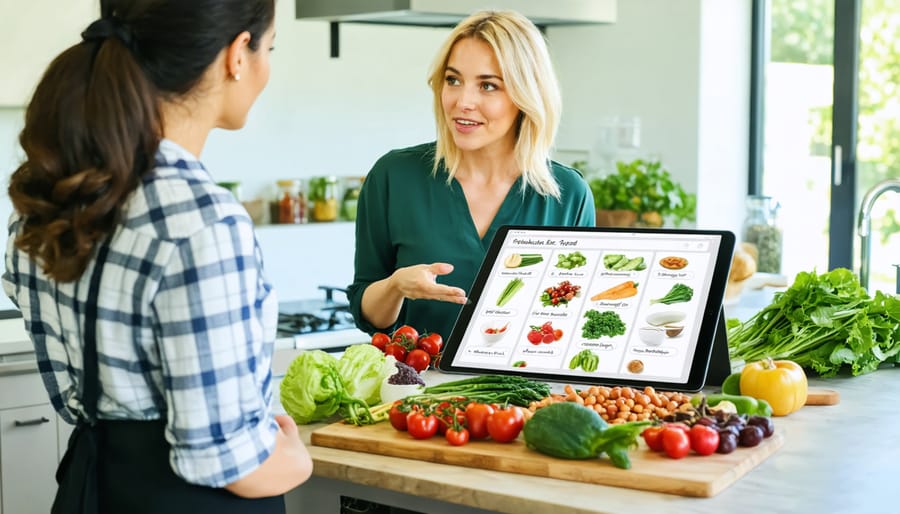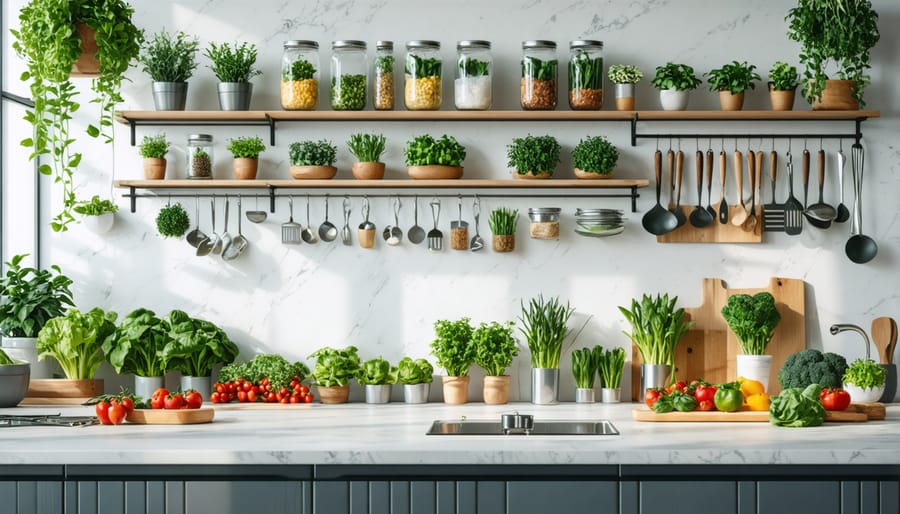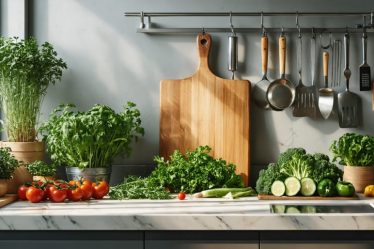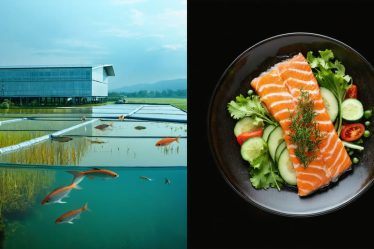
Transform your health journey with the guidance of a plant-based nutritionist – your personal navigator through the vibrant world of whole-food, plant-based living. These specialized professionals combine deep nutritional knowledge with practical strategies to help you thrive on a plant-powered diet, ensuring you get all essential nutrients while enjoying delicious, satisfying meals.
Unlike traditional nutritionists, plant-based experts understand the unique considerations of vegetarian and vegan lifestyles, from protein combining to vitamin B12 supplementation. They work closely with clients to create personalized meal plans that align with both health goals and ethical choices, making the transition to plant-based eating feel natural and sustainable.
Whether you’re a curious beginner exploring Meatless Mondays or a committed vegan seeking optimization, a plant-based nutritionist offers evidence-based solutions tailored to your lifestyle. They help demystify common concerns about protein intake, iron absorption, and omega-3 sources while teaching you how to build balanced, nutrient-dense meals that fuel your body and satisfy your taste buds.
This specialized guidance becomes your foundation for long-term success, transforming plant-based eating from a diet into a sustainable, enjoyable lifestyle that supports your health goals and values.
The Unique Role of a Plant-Based Nutritionist

Beyond Basic Nutrition
A plant-based nutritionist goes beyond basic dietary recommendations to provide specialized guidance in optimizing nutrient intake through plant-based sources. They understand the intricate balance of proteins, vitamins, and minerals needed when following a plant-based lifestyle, ensuring clients receive complete nutrition without animal products. These experts stay current with the latest plant-based alternatives, from innovative protein sources to fortified foods, helping clients make informed choices that align with their nutritional needs and personal preferences.
Their expertise includes crafting meal plans that incorporate mindful eating practices while ensuring adequate intake of crucial nutrients like B12, iron, and omega-3 fatty acids. They’re well-versed in combining different plant foods to enhance nutrient absorption and can recommend specific supplements when necessary. Whether you’re dealing with food allergies, athletic performance goals, or pregnancy requirements, a plant-based nutritionist can customize solutions that maintain optimal health while respecting your commitment to plant-based eating.
Kitchen Chemistry
Creating vibrant, nutritious plant-based meals isn’t just about tossing ingredients together – it’s a delightful dance of flavors and nutrients. Plant-based nutritionists understand that certain food combinations can enhance nutrient absorption and maximize health benefits. For instance, pairing iron-rich leafy greens with vitamin C-rich citrus fruits can boost iron absorption significantly.
The magic happens when you master simple techniques like soaking nuts and legumes to improve digestibility, or learning to massage kale to break down its tough fibers. I love showing my clients how to create creamy sauces using cashews or transform cauliflower into everything from rice to wings!
Temperature matters too – some nutrients are better preserved through gentle cooking methods like steaming, while others become more bioavailable when lightly cooked. For example, lightly sautéing tomatoes actually increases the availability of lycopene compared to eating them raw.
By understanding these kitchen chemistry basics, you can create meals that not only taste amazing but also provide optimal nutrition. It’s about working smarter, not harder, in the kitchen!
Making Plant-Based Nutrition Practical
Smart Meal Planning
Creating balanced plant-based meals doesn’t have to be complicated or time-consuming. With a few smart strategies, you can transform your meals into nutritional powerhouses while keeping things simple and delicious.
Start by following the “plant-based plate” method: fill half your plate with colorful vegetables, a quarter with whole grains or starchy vegetables, and the remaining quarter with protein-rich foods like legumes, tofu, or tempeh. This visual approach ensures you’re getting a good balance of nutrients at every meal.
Batch cooking is your best friend when it comes to plant-based meal prep. Dedicate a few hours on the weekend to prepare staples like quinoa, roasted vegetables, and legume-based dishes. These can be mixed and matched throughout the week to create varied, satisfying meals.
Keep your pantry stocked with versatile ingredients like canned beans, whole grains, nuts, and seeds. Having these basics on hand makes it easier to throw together quick, nutritious meals even on busy days. Don’t forget to incorporate seasonal produce to add variety and ensure you’re getting the freshest nutrients available.
Remember to listen to your body and adjust portions based on your individual needs. What works for one person might not work for another, and that’s perfectly okay!
Kitchen Essentials
As a plant-based nutritionist, I always remind my clients that having the right kitchen setup can make or break their healthy eating journey. Let’s stock your kitchen with these game-changing essentials that’ll make plant-based cooking a breeze!
First up, invest in quality kitchen tools: a high-speed blender for smoothies and sauces, a food processor for chopping and making energy balls, and a good set of sharp knives for prepping vegetables. A spiralizer is fantastic for creating veggie noodles, while mason jars are perfect for overnight oats and storing homemade dressings.
Your pantry should always house these staples: quinoa, brown rice, and legumes like lentils and chickpeas for protein-packed meals. Stock up on nutritional yeast (affectionately known as “nooch” in the plant-based community) for that cheesy flavor, and keep various nuts and seeds handy for healthy fats and protein boosts.
In the spice department, don’t skimp on turmeric, cumin, garlic powder, and smoked paprika – these will transform simple vegetables into crave-worthy dishes. I always tell my clients to keep dried herbs like basil, oregano, and thyme on hand too.
For the fridge, make space for plant-based milk alternatives, fresh produce, and convenient proteins like tofu and tempeh. Pro tip: freeze ripe bananas for instant smoothie creaminess and store pre-chopped vegetables for quick meal prep.

Time-Saving Techniques
As a plant-based nutritionist, I’ve discovered that the key to maintaining a healthy diet lies in effective meal preparation strategies that work with your lifestyle. One of my favorite time-saving techniques is batch cooking grains and legumes on Sunday evenings. Cook a large pot of quinoa, brown rice, or lentils, then portion them into containers for easy grab-and-go meals throughout the week.
Another game-changing approach is the “cook once, eat twice” method. When preparing dinner, double the recipe and transform leftovers into entirely new meals. For example, extra roasted vegetables can become tomorrow’s Buddha bowl or warm salad topping.
Smart kitchen tools are also essential for efficient plant-based cooking. A good food processor can chop vegetables in seconds, while an Instant Pot can cook beans from dried to done in under an hour. I encourage my clients to invest in quality containers for storage and meal prep – they’re truly worth their weight in gold!
Consider creating a “veggie prep station” in your fridge: wash and cut vegetables as soon as you get home from shopping, storing them in clear containers. This simple step makes it incredibly easy to throw together quick, nutritious meals when time is tight.
Common Challenges and Solutions
Protein Solutions
Gone are the days when people questioned whether you could get enough protein from plants! As a plant-based nutritionist, I love showing my clients just how abundant and diverse plant protein sources can be. From mighty legumes like lentils, chickpeas, and black beans to protein-packed quinoa and hearty tempeh, the options are endless.
Let’s break down some numbers: a cup of cooked lentils packs about 18 grams of protein, while a serving of tempeh delivers around 20 grams. Even foods you might not expect, like green peas and oats, contribute significantly to your daily protein needs. The key is combining different plant proteins throughout the day to ensure you’re getting all essential amino acids.
I often recommend starting your day with a protein-rich smoothie bowl made with plant-based protein powder, chia seeds, and hemp hearts. For lunch, try a Buddha bowl loaded with quinoa, roasted chickpeas, and steamed edamame. Dinner could feature a hearty black bean and sweet potato burger on a whole-grain bun.
Remember, most Americans actually consume more protein than they need. For someone eating 2,000 calories daily, aim for about 50-60 grams of protein. By incorporating a variety of plant proteins into your meals, you’ll easily meet your requirements while enjoying delicious, nutrient-dense foods.

Family-Friendly Transitions
Making plant-based meals appealing to the whole family doesn’t have to be a struggle. As a plant-based nutritionist, I’ve helped countless families navigate transitioning to plant-based eating with minimal resistance and maximum enjoyment.
Start by introducing familiar favorites with a plant-based twist. Love taco night? Keep it! Just swap the ground beef for seasoned lentils or walnut meat, and load up on colorful toppings everyone already enjoys. Pizza nights can feature creative veggie combinations and dairy-free cheese that melts beautifully.
Get the kids involved in meal planning and preparation. When children help choose recipes and participate in cooking, they’re more likely to try new foods. Create fun names for dishes – “power bowls” and “rainbow pasta” sound more exciting than “vegetable quinoa” or “primavera.”
Remember that transition periods look different for every family. Some might embrace change quickly, while others need more time to adjust. Consider starting with “Meatless Mondays” or making plant-based versions of family favorites available alongside traditional options.
Keep mealtimes positive and pressure-free. Focus on abundance rather than restriction, and celebrate small wins as your family discovers new favorite foods together. The key is making plant-based eating feel natural, not forced.
Getting Started with a Plant-Based Nutritionist
Starting your journey with a plant-based nutritionist is like having a knowledgeable friend guide you through your kitchen transformation. The first step is usually a comprehensive initial consultation where you’ll discuss your current eating habits, health goals, and lifestyle. Don’t worry about having everything figured out – that’s exactly what your nutritionist is there to help with!
Once you’ve had your first meeting, your nutritionist will typically provide you with a personalized action plan. This might include a detailed meal plan, shopping lists, and recipe suggestions tailored to your preferences and cooking abilities. Think of it as your roadmap to plant-based success!
To make the most of your nutrition sessions, keep a food diary for at least a week before your first appointment. This helps your nutritionist understand your current eating patterns and identify areas where you might need extra support. Also, take photos of your pantry and fridge – this visual inventory can be incredibly helpful for planning your kitchen makeover.
One of the most valuable aspects of working with a plant-based nutritionist is the practical kitchen guidance they provide. Many will offer virtual pantry tours, cooking demonstrations, or even accompany you on grocery shopping trips. They can show you how to properly prepare ingredients like tempeh and quinoa, and teach you time-saving techniques for batch cooking and meal prep.
Remember to be open about your challenges and preferences. If you’re not a fan of certain vegetables or you’re worried about protein intake, your nutritionist can help you find creative solutions that work for you. They can also guide you through social situations, travel, and eating out while maintaining your plant-based lifestyle.
Most importantly, view this as a collaborative relationship. Your nutritionist is there to educate, support, and empower you, not to judge or restrict. Set realistic goals together, celebrate small victories, and don’t hesitate to ask questions – even the ones you think might be silly. With professional guidance, your transition to plant-based eating can be an exciting and rewarding journey rather than an overwhelming challenge.
Embarking on a plant-based journey can be one of the most rewarding decisions you’ll make for your health, the environment, and your overall well-being. As someone who made this transition myself, I can tell you that working with a plant-based nutritionist transformed what could have been an overwhelming experience into an exciting and empowering adventure.
These dedicated professionals offer more than just meal plans – they provide personalized guidance, evidence-based recommendations, and the support you need to thrive on a plant-based diet. Whether you’re curious about dipping your toes into Meatless Mondays or ready to fully embrace plant-based living, a qualified nutritionist can help you navigate this path with confidence.
Remember, every small step counts. You don’t have to make dramatic changes overnight. Start where you are, and allow yourself to grow and learn at your own pace. The plant-based community is welcoming and supportive, filled with people at various stages of their journey.
I encourage you to reach out to a plant-based nutritionist and discover how they can help you achieve your health and wellness goals. With their expertise and guidance, you’ll find that eating plant-based isn’t just about what you’re leaving behind – it’s about opening doors to a vibrant, delicious, and nourishing way of life. Your future self will thank you for taking this step toward better health and conscious living.



